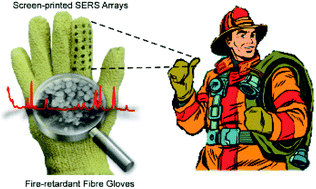A wearable screen-printed SERS array sensor on fire-retardant fibre gloves for on-site environmental emergency monitoring†
Abstract
Glove-based wearable sensors can offer the potential ability to a fast and on-site environmental threat assessment, which is crucial for timely and informed incident management. In this study, an on-demand surface-enhanced Raman scattering (SERS) array sensor has been patterned on fire-retardant fibre gloves via the screen-printing technique in large batches. The screen-printed ink contains one-pot synthesized silver nanoparticle and molybdenum disulfide nanocomposite (Ag/MoS2), and polyanionic cellulose (PAC) as a new adhesive agent. Rhodamine 6G (R6G) was employed as an initial probe molecule to systematically evaluate the performance of the resulting sensor. The results suggest that the fabricated fire-retardant screen-printed SERS array sensor displays high reproducibility and stability at 250 °C, with the lower detection limit of 10−13 M for R6G. The spot-to-spot SERS signals show that the intensity variation was less than 10%. Besides, the SERS signals can be maintained over 7 weeks. Further investigation was then successfully carried out to detect polycyclic aromatic hydrocarbons (PAHs), which are commonly used as flammable chemicals. In our perception, this wearable fire-retardant screen-printed SERS array sensor would be an ideal candidate for practical on-site environmental emergency monitoring due to its fire-retardant capability and timely measurement on a portable carrier.



 Please wait while we load your content...
Please wait while we load your content...